 |
Site created 12/15/97.

page created: 6/26/07
 Barrie Maxwell - Main Page |
| Classic
Reviews Round-Up #38 and New Announcements Being the time of year it is, the studios tend to release a lot of western product about now and 2007 is no exception. The 100th anniversary of what would have been John Wayne's birthday in May also has added to this year's western lode. So this edition of the column focuses on reviews of the latest western DVDs with several serials (mainly non-western) thrown in for good measure. Some 25 releases comprising 36 titles in total are covered. The western features are: from Fox (Broken Arrow, Convict Stage, Fort Courageous, Fury at Furnace Creek, White Feather); from Grapevine (Bob Steele in Cinecolor); from MGM (The Sergio Leone Anthology); from Paramount (True Grit: Special Collector's Edition); from Universal (Clint Eastwood: Western Icon Collection, Unconquered); from VCI (Cisco Kid Western Collection); and from Warner Bros. (Allegheny Uprising, The Big Stampede, Haunted Gold, The Man from Monterey, Ride Him Cowboy, Rio Bravo, Somewhere in Sonora, The Telegraph Trail). The serials are: from AC Comics (The Fighting Devil Dogs); from Hermitage Hill (The Mystery of the Riverboat); from Restored Serials (The Green Archer); from The Serial Squadron (Gang Busters); and from VCI (The Royal Mounted Rides Again, Scouts to the Rescue). As usual, I've also compiled the latest new announcements and they'll be found following the reviews. Reviews Two of Fox's recent western releases - Broken Arrow (1950) and White Feather (1955) - have much in common beyond the more liberal attitude to portraying the native American than theretofore prevalent in Hollywood. 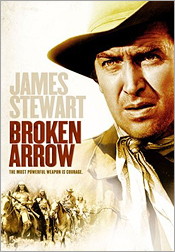 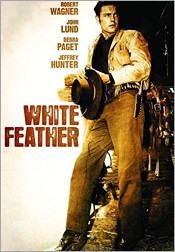 Both are loosely based on true events involving the signing of treaties between Indians and whites; both feature a lone white (James Stewart in the case of Broken Arrow and Robert Wagner in White Feather) who befriends the Indians and spearheads peace between the two sides; in both cases, the white man falls in love with a young Indian woman (Debra Paget in each film); and in both films, the main Indian characters are played by white actors (Jeff Chandler as Cochise in Broken Arrow, and Jeffrey Hunter, Hugh O'Brien, and Eduard Franz as Little Dog, American Horse, and Broken Hand respectively in White Feather). Although both films provide a satisfying dose of western adventure, White Feather's chief attribute is earnestness so that the better script and tighter direction (attributable to Delmer Daves' facility with western action) of Broken Arrow make it the better of the two. James Stewart was then at the beginning of his period of 1950s western films that helped redefine his screen persona at the time, and he brings a blend of both real-life and screen maturity to his protaganist that Robert Wagner didn't yet possess. Wagner's youth and enthusiasm counted for a lot in playing his White Feather role, but the level of gravitas wasn't quite there. Whether one gets exorcized over the practice of casting whites in non-white roles or not, there's no denying that the work of Jeff Chandler, Jeffrey Hunter, and Hugh O'Brian as Indians is quite effective. Chandler particularly plays the Cochise role very compellingly and was rewarded with a best supporting actor Oscar nomination. Those looking for political correctness will at least be pleased to see the likes of Jay Silverheels, Chief Thundercloud, and Iron Eyes Cody prominently featured in Broken Arrow. Broken Arrow, along with the same year's Devil's Doorway (an even-better film crying out for a DVD release), is credited with bringing a new Hollywood attitude to the film industry's portrayal of the Indians. Seldom thereafter would they simply be the enemy in westerns because their skins were red. Fox's DVD presentation of Broken Arrow is quite pleasing. It's full frame as originally shot. The location work in Arizona (Sedona, Tucson) and in Lone Pine, California is well conveyed in the bright, sharp image and generally vibrant colours. Some modest grain is evident as are some speckles and the odd scratch, but fans should be well satisfied. White Feather is presented in an anamorphically-enhanced 2.35: 1 transfer of the CinemaScope original. Colours are not as vibrant, although that's partly attributable to the dusty-looking Durango location work. Still, colour fidelity seems a little questionable in some scenes. Edge effects are not an issue on either film. The sound on both is in good shape, offering clear precise dialogue. White Feather's mix is a Dolby 4.0 surround one that does provide some front directionality, but very limited rear effects. For extras, both discs sport interactive pressbook galleries, various stills galleries and the original theatrical trailers. White Feather also adds two very short Fox Movietone newsreel segments. Broken Arrow is a definite recommendation. Western fans may want to try a rental on White Feather. 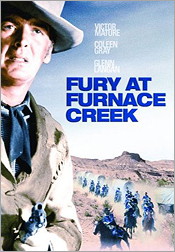 A somewhat prosaic but still entertaining western is 1948's Fury at Furnace Creek, an outing that stars Victor Mature as a gambler/gunfighter who tries to prove his father innocent of wrong-doing in connection with a massacre at Fort Furnace Creek and in so doing runs afoul of both his brother and the real villain behind the massacre. Mature is likable and quite forceful in the lead role, but Glenn Langan gives a rather flat portrayal of the brother, making one wish that the original choice for the role, George Montgomery, had not asked to be released from his contract. The villains are played by the familiar but effective Albert Dekker, Fred Clark, and Roy Roberts (the latter in a rather obvious fake beard). Look also for good work by Jay Silverheels and Reginald Gardiner in key supporting roles. The film has a plot that's well-constructed and takes good advantage of location shooting at Kanab, Utah where the fort set was constructed. Fox house director Bruce Humberstone keeps the action moving well and the film flies by briskly in 88 minutes. Interestingly the film's source material, a novel by David Garth entitled "Four Men and a Prayer", was previously filmed in 1938 by director John Ford under the same title as the book and set in India with Richard Greene starring. Fox delivers the film on DVD in a full frame presentation as originally projected. The black and white image is in good condition, looking sharp and fairly clean. Shadow detail is very good and no edge effects are evident. The mono sound provides clear dialogue with only very minor background hiss. The supplements include various stills galleries (concept and poster art, behind the scenes, publicity and production) and trailers for four other Fox westerns. The film's original theatrical trailer, which features voice-over by Gregory Peck, is also included. Recommended. 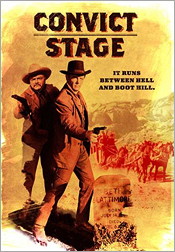  Don "Red" Barry was a western star at Republic in the early1940s, and later became a familiar face with parts in many TV series of the 1960s and 1970s. While his later TV work was more likely to be of a non-western nature, in the 1950s and early 1960s, he was still firmly focused on the western. Although the B series western was long dead by the mid-1960s, the flavour of those films was still evident in a series of westerns that A.C. Lyles produced for Paramount at that time. Richly peopled with veteran western players, Barry found employment in a few of them (e.g. Law of the Lawless, Town Tamer, Apache Uprising). At the same time he also associated himself with Steve Productions, an independent unit releasing through Fox. For them, he made three modest westerns (Convict Stage, War Party, and Fort Courageous) in 1965 and two have now been released on DVD by Fox (Convict Stage and Fort Courageous). In the latter, a cavalry officer wrongly accused of rape takes command of a troop when its commanding officer is killed during an Indian attack. The troop makes a last stand at a fort where a previous massacre has left only one survivor (Barry). In Convict Stage, a gunfighter tries to avenge the murder of his sister only to have sheriff (Barry) intervene in order to bring the accused to justice. Neither of these films is anything more than a very minor entertainment. One has the feeling that the producers and Barry (who also wrote the story for Convict Stage) were trying to recreate the feel of the old B series western, but the best of such films were a product of their time (late 1930s through early 1940s) and impossible to replicate some two decades later using budgets without the same buying power, crews without the same production efficiency behind them as the old Republic studio, and players generally without the same charisma. The best that one can say for the films is that the reliable and long-time supporting western player Harry Lauter finally gets his due with the starring role in Convict Stage and a major supporting one in Fort Courageous. Aside from him, Don Barry is the best of the rest of the cast members in both films. Actually, one wonders what prompted Fox to release these titles, but their appearance at least makes it plain that one should not give up hope on seeing any obscure film make it to DVD eventually. Both black and white films are presented with 1.85:1 anamorphic transfers that are about as good as one should expect. Neither is startling, but both are reasonably sharp with good shadow detail and no edge effects in evidence. Speckles and a few scratches along with modest grain are present. The mono sound is quite adequate in both instances and extras in each case include an interactive pressbook gallery, still photo galleries, and the original theatrical trailer. 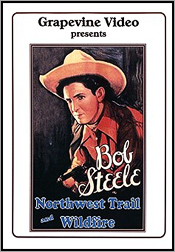 In 1945, an independent production unit called Action Pictures headed by Robert Lippert made several low budget features filmed in Cinecolor. The first two starred the long-time cowboy star and always interesting Bob Steele and were released theatrically by a new firm called Screen Guild Productions (which Lippert also had an interest in and would reorganize four years later into Lippert Pictures Inc.). These two films - Northwest Trail and Wildfire - have now been released as a double feature DVD by Grapevine Video under the title Bob Steele in Cinecolor. In Northwest Trail, Steele plays a Mountie who must investigate the robbery of a large sum of money from a young woman whom he was escorting through the wilderness. In Wildfire, Steele is a horse dealer who becomes involved with a wild horse that is believed to be luring stock away from ranchers. Northwest Trail is much the more interesting of the two films, benefiting greatly from a nice performance by Joan Woodbury as a headstrong young woman. The plot resolution is decently camouflaged and some fine location work is effectively employed. The supporting cast includes the likes of familiar supporting faces such as Raymond Hatton, John Litel, Charles Middleton, and John Hamilton. The DVD transfer is by far the stronger of the two although it still has many problems. Colour fidelity is decent for the first half, but deteriorates thereafter with resolution problems particularly evident in the final third. Scratches and speckles are rife throughout. Cinecolor never conveyed a particularly crisp-looking product and fuzziness is an issue at times with this transfer too. A noticeable splice with a significant number of missing frames is very evident at about the 20-minute mark. The mono sound is workable but sounds muffled at times and as though being transmitted underwater at others. Wildfire is a pretty stock B western with a good villain in John Miljan and reasonable support for Steele from Eddie Dean and Sterling Holloway. The DVD transfer is workable at best, being frequently fuzzy and rife with scratches and speckles. The colour is decent to start but quickly deteriorates into murkiness. A noticeable splice occurs at about the 30-minute mark. The mono sound is a little muffled also, but overall is superior to that of the other feature. For Bob Steele enthusiasts only.  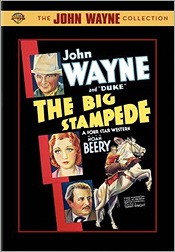   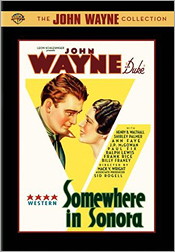 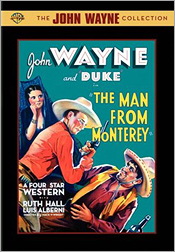 Speaking of B series westerns, John Wayne turned out six such efforts for Warner Bros. in the early 1930s. Warners used its silent Ken Maynard westerns as the basis for four of the entries, allowing for the introduction of stock footage to minimize costs. In the same spirit, background music was also kept to a minimum, usually only present during the opening credits and the closing scenes. In order of original release, the films were: Ride Him, Cowboy (1932), The Big Stampede (1932), Haunted Gold (1932), The Telegraph Trail (1933), Somewhere in Sonora (1933), and The Man from Monterey (1933). The Telegraph Trail and The Man from Monterey are the two that are not remakes of silent Maynard westerns. The films were previously released on two triple feature DVDs by Warners last autumn, but have now been re-released as six single feature discs in honour of Wayne's 100th anniversary. The six films provide fairly consistent good entertainment with the three 1932 features being the best of the bunch. The Man from Monterey, the final film of the series, is the best of the second year's efforts. Wayne typically plays a character named "John" who rides a horse named "Duke". In Ride Him, Cowboy, he tracks down a killer responsible for a string of robberies; in The Big Stampede, he is a sheriff who brings an end to a cattle rustler's (Noah Beery) schemes; in Haunted Gold, he returns the title of an abandoned but still lucrative mine to its rightful owner; in The Telegraph Trail, he is a scout who ensures the completion of stringing telegraph wires across the plains; in Somewhere in Sonora, he joins a gang of robbers in order to bring them to justice; and in The Man from Monterey, he helps a Spanish landowner safeguard his lands. Early development of the Wayne western persona is the main reason to view these films. Few of the other cast members are of a major nature, so there are no distractions in that regard. The films themselves are brisk and generally entertaining outings with fairly good plots and sufficient action to satisfy. Anyone familiar with the ubiquitous Lone Star westerns (the films that abound on public domain discs) that Wayne made in the 1933-1935 period will find much of a similar tone and style in these Warner titles. The DVD transfers (all are full frame as originally released) are quite presentable. There are plenty of scratches and speckles, but image sharpness and detail is acceptable. Shadow detail is sometimes a problem. The mono sound is quite clear although minor background hiss is present. There are no supplements or chapter selections provided. Interestingly, although no theatrical trailers are present, those for several of the films can be found on the new two-disc Rio Bravo release. For John Wayne enthusiasts. Western fans in general should try a rental. |
on to Page Two
 |
| Site
designed for 1024 x 768 resolution, using 16M colors and .gif 89a
animation. © 1997-2015 The Digital Bits, Inc., All Rights Reserved. billhunt@thedigitalbits.com |